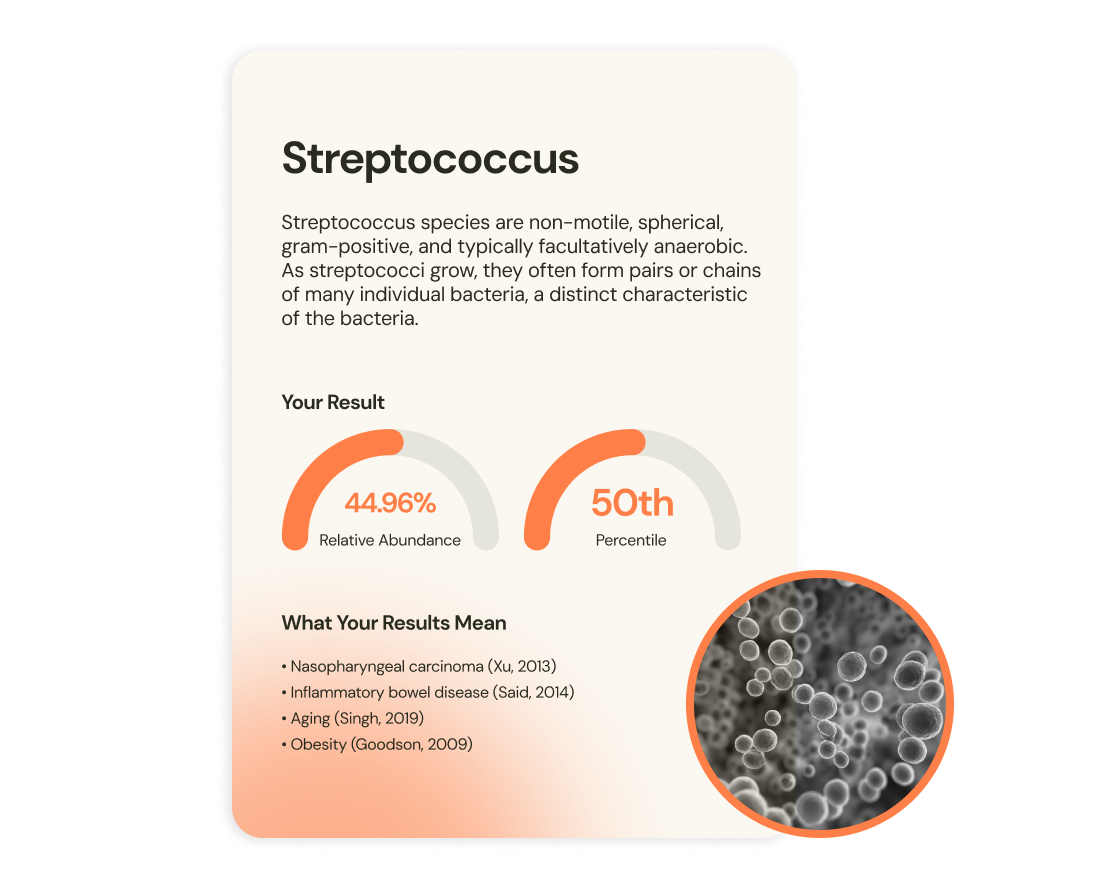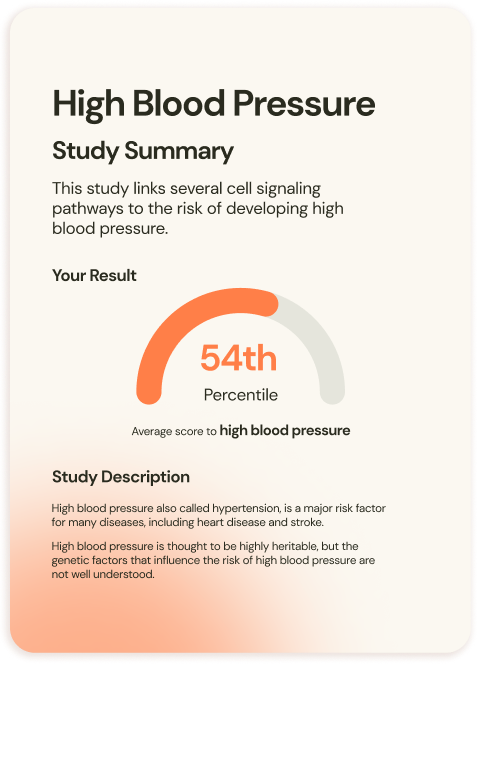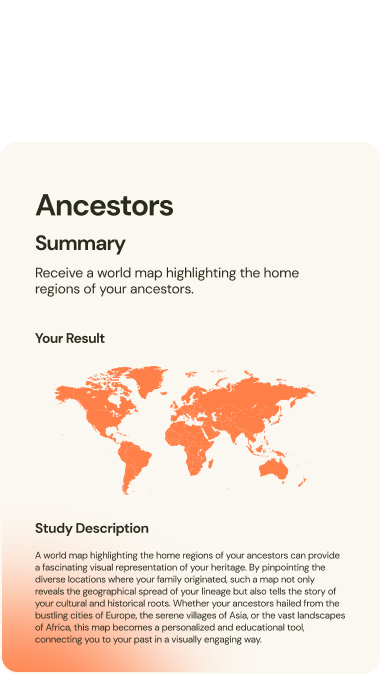DNA Reports
Here are some of the insights you’ll get with DNA Complete …
Powerful Personalized Health Reports
Discover what your DNA means for your health and wellness with our comprehensive DNA reports and research library.
With DNA Complete, you’ll get access to up to 350+ and counting (depending on tier selection) personalized health reports that span hundreds of health and wellness factors. From insights on aging, to diseases, to nutrition and diet, you’ll gain a deeper understanding of yourself, your body, and how you can thrive — all based on 100% of your unique DNA. DNA Complete uses Whole Genome Sequencing, which analyzes 100% of your DNA, compared to typical DNA Ancestry tests that analyze less than 1% of your DNA.
Here are the categories of the personalized health & wellness reports that you’ll get with DNA Complete :
1x 100% of your DNA* |
30x 100% of your DNA* |
100x 100% of your DNA* |
|
Addiction Addiction Reports highlight genetic markers that could impact an individual’s tendencies towards addictive behaviors and substances. These reports offer insights into tendencies for issues like nicotine dependence, alcohol consumption, and other substance use behaviors. Understanding these genetic tendencies can inform individuals’ awareness about their health. |
6
| 9
| 12
|
Aesthetic and Cosmetic Genetics |
6
|
9
|
12
|
Alzheimer's Disease and Neurodegenerative Conditions Alzheimer’s Disease and Neurodegenerative Conditions Reports provide genetic insights into conditions like Alzheimer’s and Parkinson’s disease. Understanding these tendencies can support potential planning and lifestyle adjustments. |
5
|
7
|
9
|
Autoimmune Disease Autoimmune Disease Reports identify genetic tendencies to conditions such as rheumatoid arthritis and celiac disease. They offer information that can assist individuals in understanding their genetic traits related to autoimmune responses. |
10
|
15
|
19
|
Brain Health Brain Health Reports analyze genetic markers associated with brain health and function, covering conditions like neurodegenerative diseases and neurological conditions. These reports aim to provide information that can help individuals understand their genetic tendencies and make informed choices related to lifestyle and wellness. |
21
|
32
|
42
|
Cancer
Cancer Reports offer genetic insights into tendencies for various types of cancer, including melanoma, breast and prostate cancers. They provide information that may guide individuals towards personalized approaches for health monitoring and lifestyle adjustments. |
23
|
29
|
38
|
Environmental Sensitivity Environmental Sensitivity Reports identify genetic traits affecting an individual’s reaction to environmental factors such as allergens and pollutants. Understanding these tendencies can help individuals manage their environments to potentially improve overall well-being. |
6
|
9
|
11
|
Gastrointestinal Health Gastrointestinal Health Reports focus on genetic factors influencing gastrointestinal health, including conditions like irritable bowel syndrome, Crohn’s disease, and ulcerative colitis. These reports offer insights that may support personalized approaches to diet and lifestyle management. |
8
|
12
|
15
|
Basic Genetic Traits Basic Basic Genetic Traits Reports explain single variants in DNA that influence trait categories such as appearance & hormones, behavior & perception, body & athleticism and nutrition & diet. |
29
|
29
|
29
|
Heart Disease and Cardiovascular Health Heart Disease and Cardiovascular Health Reports analyze genetic markers associated with cardiovascular conditions like coronary artery disease and hypertension. These insights can inform individuals about genetic tendencies related to heart health and guide them towards lifestyle choices that promote cardiovascular wellness. |
19
|
27
|
37
|
Lifestyle & Wellness Lifestyle & Wellness Genetic Reports explore how genetic variations impact responses to factors like diet and sleep. They provide insights that may help individuals optimize their health and well-being based on their genetic makeup. |
13
|
20
|
26
|
Longevity Longevity Genetic Reports examine markers related to aging, healthspan, and potential longevity. Understanding these factors can inform lifestyle choices aimed at promoting overall health and quality of life as individuals age. |
36
|
54
|
71
|
Mental Health Mental Health Reports focus on genetic tendencies related to conditions such as depression, anxiety and bipolar traits. They offer information that may assist individuals in understanding their genetic predispositions and exploring strategies for mental wellness. |
16
|
24
|
32
|
Obesity and Metabolic Health |
6
|
9
|
12
|
Reproductive Health and Family Planning Reproductive Health and Family Planning Reports provide genetic insights into fertility and factors affecting offspring. They are valuable for individuals interested in understanding genetic tendencies related to reproductive health and family planning considerations. |
4
|
6
|
8
|
| GRAND TOTAL | 208 | 292 | 373 |
30x
100% of your DNA*
(sequenced an average of 30 times)
6
- Addiction
- Alcohol flush reaction
- Binge eating disorder
- Cannabis use disorder
- Food addiction
- Heavy alcohol consumption
9
- Addiction
- Alcohol flush reaction
- Binge eating disorder
- Cannabis use disorder
- Food addiction
- Heavy alcohol consumption
- Nicotine dependence
- Opioid use
- Problematic alcohol use
12
- Addiction
- Alcohol flush reaction
- Binge eating disorder
- Cannabis use disorder (x2)
- Food addiction
- Heavy alcohol consumption
- Higher alcohol consumption (x2)
- Nicotine dependence
- Opioid use
- Problematic alcohol use
6
- A more attractive face
- Acne
- Alopecia areata
- Darker eye color
- Familial short stature
- Hair color
9
- A more attractive face
- Acne
- Alopecia areata
- Darker eye color
- Familial short stature
- Hair color
- Male-pattern baldness
- Moles
- Nasal polyps
12
- A more attractive face
- Acne (x2)
- Alopecia areata
- Darker eye color
- Familial short stature
- Hair color
- Male-pattern baldness
- Moles
- Nasal polyps
- NSCL/P
- Orofacial clefts
5
- Alzheimer’s disease
- Amyotrophic lateral sclerosis
- CTS
- Lewy body dementia
- Multiple sclerosis
7
- Alzheimer’s disease
- Amyotrophic lateral sclerosis
- CTS
- Lewy body dementia
- Multiple sclerosis
- Parkinson’s disease
- Resilience to Alzheimer’s disease
9
- Alzheimer’s disease (x3)
- Amyotrophic lateral sclerosis
- CTS
- Lewy body dementia
- Multiple sclerosis
- Parkinson’s disease
- Resilience to Alzheimer’s disease
10
- Addison’s disease
- Alopecia areata
- Ankylosing spondylitis
- Atopic dermatitis
- Autoimmune thyroid disease
- Celiac disease
- Dermatomyositis
- Eosinophilic esophagitis
- Graves’ disease
- Myasthenia gravis
15
- Addison’s disease
- Alopecia areata
- Ankylosing spondylitis
- Atopic dermatitis
- Autoimmune thyroid disease
- Celiac disease
- Dermatomyositis
- Eosinophilic esophagitis
- Graves’ disease
- Myasthenia gravis
- Pernicious anemia
- Psoriasis
- Rheumatoid arthritis
- Sjögren’s syndrome
- SLE
19
- Addison’s disease
- Alopecia areata
- Ankylosing spondylitis
- Atopic dermatitis (x2)
- Autoimmune thyroid disease
- Celiac disease
- Dermatomyositis
- Eosinophilic esophagitis
- Graves’ disease
- Myasthenia gravis
- Pernicious anemia
- Psoriasis
- Rheumatoid arthritis (x2)
- Sjögren’s syndrome
- SLE
- Systemic sclerosis
- Vitiligo
21
- Accelerated brain aging
- Beat synchronization
- Brain aneurysm
- Cerebral small vessel disease
- Cluster headaches
- Cognition of cinnamon smell
- CSVD
- Dopamine regulation
- Ebbinghaus illusion overestimation
- Epilepsy
- Essential tremor
- Fainting
- Febrile seizures
- Glaucoma
- Kawasaki disease
- Keratoconus
- Lacunar stroke
- Large ICV
- Larger brain volume
- Larger corneal hysteresity
- Larger corneal resistance factor
32
- Accelerated brain aging
- Beat synchronization
- Brain aneurysm
- Cerebral small vessel disease
- Cluster headaches
- Cognition of cinnamon smell
- CSVD
- Dopamine regulation
- Ebbinghaus illusion overestimation
- Epilepsy
- Essential tremor
- Fainting
- Febrile seizures
- Glaucoma
- Kawasaki disease
- Keratoconus
- Lacunar stroke
- Large ICV
- Larger brain volume
- Larger corneal hysteresity
- Larger corneal resistance factor
- Larger cortical surface area
- Larger optic disc
- Larger stroke volume
- Larger subcortical brain volume
- Long-term memory
- Migraine
- Migraine without aura
- Primary open-angle glaucoma
- Refractive errors
- Restless leg syndrome
- White matter hyperintensities
42
- Accelerated brain aging
- Beat synchronization
- Brain aneurysm (x2)
- Cerebral small vessel disease
- Cluster headaches (x2)
- Cognition of cinnamon smell
- CSVD
- Dopamine regulation
- Ebbinghaus illusion overestimation
- Epilepsy (x3)
- Essential tremor
- Fainting
- Febrile seizures
- Glaucoma (x2)
- Kawasaki disease
- Keratoconus (x2)
- Lacunar stroke
- Large ICV
- Larger brain volume (x3)
- Larger corneal hysteresity
- Larger corneal resistance factor
- Larger cortical surface area
- Larger optic disc
- Larger stroke volume
- Larger subcortical brain volume
- Long-term memory
- Migraine (x2)
- Migraine without aura
- Migraines
- Primary open-angle glaucoma
- Refractive errors
- Restless leg syndrome
- White matter hyperintensities
23
- Acute lymphoblastic leukaemia
- Aerodigestive squamous cell cancer
- Bladder cancer
- Bone cancer
- Brain cancer
- Breast cancer
- Cervical cancer
- CLL
- Colorectal cancer
- DLBCL
- Endometrial cancer
- Glioma
- Hepatocellular carcinoma
- HER2-enriched-like breast cancer
- Luminal A-like breast cancer
- Luminal B/HER2-negative-like breast cancer
- Luminal B-like breast cancer
- Lung adenocarcinoma
- Lung cancer
- Melanoma
- Ovarian cancer
- Pancreatic cancer
- Prostate cancer
29
- Acute lymphoblastic leukemia
- Aerodigestive squamous cell cancer
- Bladder cancer
- Bone cancer
- Brain cancer
- Breast cancer
- Cervical cancer
- CLL
- Colorectal cancer
- DLBCL
- Endometrial cancer
- Glioma
- Hepatocellular carcinoma
- HER2-enriched-like breast cancer
- Luminal A-like breast cancer
- Luminal B/HER2-negative-like breast cancer
- Luminal B-like breast cancer
- Lung adenocarcinoma
- Lung cancer
- Male breast cancer
- Melanoma
- Myeloproliferative neoplasms
- Ovarian cancer
- Pancreatic cancer
- Prostate cancer
- Renal cell carcinoma
- Squamous cell carcinoma
- Thyroid cancer
- Triple-negative breast cancer
38
- Acute lymphoblastic leukemia
- Aerodigestive squamous cell cancer
- Bladder cancer
- Bone cancer
- Brain cancer
- Breast cancer (x3)
- Cervical cancer
- CLL (x2)
- Colorectal cancer
- DLBCL
- Endometrial cancer
- Glioma
- Hepatocellular carcinoma
- HER2-enriched-like breast cancer
- Luminal A-like breast cancer
- Luminal B/HER2-negative-like breast cancer
- Luminal B-like breast cancer
- Lung adenocarcinoma
- Lung cancer
- Male breast cancer
- Melanoma (x2)
- Myeloproliferative neoplasms (x2)
- Ovarian cancer
- Pancreatic cancer
- Prostate cancer (x2)
- Renal cell carcinoma
- Squamous cell carcinoma (x2)
- Squamous cell lung carcinoma
- Thyroid cancer (x2)
- Triple-negative breast cancer
6
- Fewer mosquito bites
- Food intolerance
- Hay fever
- Hay fever and asthma
- Increased intensity of fish smell perception
- Increased intensity of licorice smell perception
9
- Fewer mosquito bites
- Food intolerance
- Hay fever
- Hay fever and asthma
- Increased intensity of fish smell perception
- Increased intensity of licorice smell perception
- IURDs
- Resistance to severe malaria
- Resistance to transmissible CJD
11
- Fewer mosquito bites
- Food intolerance
- Hay fever (x2)
- Hay fever and asthma
- Increased intensity of fish smell perception
- Increased intensity of licorice smell perception
- IURDs
- Resistance to severe malaria
- Resistance to transmissible CJD
- Urticaria
8
- Appendicitis
- Barrett’s esophagus (x2)
- Crohn’s disease
- Diverticular disease
- Gallstones
- GERD
- IBS
12
- Appendicitis
- Barrett’s esophagus (x2)
- Crohn’s disease
- Diverticular disease
- Gallstones (x2)
- GERD
- Helicobacter pylori infection (x2)
- IBS
- Ulcerative colitis
15
- Appendicitis
- Barrett’s esophagus (x2)
- Crohn’s disease
- Diverticular disease (x2)
- Gallstones (x2)
- GERD
- Helicobacter pylori infection (x2)
- IBS
- Irritable bowel syndrome
- Ulcerative colitis (x2)
29
- Earwax type
- Freckling
- Hair thickness
- Testosterone
- Alcohol sensitivity
- Asparagus Metabolite Odor
- Caffeine Use
- Cilantro preference
- Misophonia
- Nicotine response
- Pain sensitivity
- Snacking behavior
- Blood pressure
- Height
- Jimmy legs
- Longevity
- Muscle strength
- Muscle volume
- Nearsightedness
- Obesity
- Physical conditioning
- Skin sensitivity
- Sleep depth
- Hunger response
- Lactose intolerance
- Sweet tooth
- Vitamin B12
- Vitamin C
- Vitamin D
29
- Earwax type
- Freckling
- Hair thickness
- Testosterone
- Alcohol sensitivity
- Asparagus Metabolite Odor
- Caffeine Use
- Cilantro preference
- Misophonia
- Nicotine response
- Pain sensitivity
- Snacking behavior
- Blood pressure
- Height
- Jimmy legs
- Longevity
- Muscle strength
- Muscle volume
- Nearsightedness
- Obesity
- Physical conditioning
- Skin sensitivity
- Sleep depth
- Hunger response
- Lactose intolerance
- Sweet tooth
- Vitamin B12
- Vitamin C
- Vitamin D
29
- Earwax type
- Freckling
- Hair thickness
- Testosterone
- Alcohol sensitivity
- Asparagus Metabolite Odor
- Caffeine Use
- Cilantro preference
- Misophonia
- Nicotine response
- Pain sensitivity
- Snacking behavior
- Blood pressure
- Height
- Jimmy legs
- Longevity
- Muscle strength
- Muscle volume
- Nearsightedness
- Obesity
- Physical conditioning
- Skin sensitivity
- Sleep depth
- Hunger response
- Lactose intolerance
- Sweet tooth
- Vitamin B12
- Vitamin C
- Vitamin D
19
- Abnormal bleeding or bruising
- Aortic calcification/atherosclerosis
- Aortic stenosis
- Apolipoprotein A-I level
- Atrial fibrillation
- Bigger left ventricular ejection fraction
- Brugada syndrome
- Cardiorespiratory fitness
- Cardiovascular disease
- Coronary artery calcification
- Coronary artery disease
- Dilated cardiomyopathy
- EGPA
- Elevated systolic blood pressure
- Faster resting heart rate
- Fat metabolism
- Fibromuscular dysplasia
- Heart failure
- MTHFR gene
27
- Abnormal bleeding or bruising
- Aortic calcification/atherosclerosis
- Aortic stenosis
- Apolipoprotein A-I level
- Atrial fibrillation
- Bigger left ventricular ejection fraction
- Brugada syndrome
- Cardiorespiratory fitness
- Cardiovascular disease
- Coronary artery calcification
- Coronary artery disease
- Dilated cardiomyopathy
- EGPA
- Elevated systolic blood pressure
- Faster resting heart rate
- Fat metabolism
- Fibromuscular dysplasia
- Heart failure (x2)
- High blood pressure
- Higher Apolipoprotein B level
- HRV
- Hypertrophic cardiomyopathy
- Larger left ventricular end-diastolic volume
- Larger left ventricular end-systolic volume
- Long QT syndrome
- Low-density lipoprotein cholesterol
- MTHFR gene
37
- Abnormal bleeding or bruising
- Aortic calcification/atherosclerosis
- Aortic stenosis
- Apolipoprotein A-I level
- Atrial fibrillation (x2)
- Bigger left ventricular ejection fraction
- Brugada syndrome
- Cardiorespiratory fitness
- Cardiovascular disease
- Coronary artery calcification
- Coronary artery disease (x2)
- Dilated cardiomyopathy
- EGPA
- Elevated systolic blood pressure
- Faster resting heart rate
- Fat metabolism
- Fibromuscular dysplasia
- Heart failure (x2)
- High blood pressure
- Higher Apolipoprotein B level
- HRV
- Hypertrophic cardiomyopathy
- Larger left ventricular end-diastolic volume
- Larger left ventricular end-systolic volume
- Long QT syndrome
- Low-density lipoprotein cholesterol
- Mosaic loss of chromosome Y (x3)
- Osmotic hemolysis of red blood cells
- PAD
- Spontaneous coronary artery dissection
- Thrombophilia
- MTHFR gene
13
- Ambidexterity
- Bad sleep quality
- Better lung function (higher FEV1/FVC ratio)
- Daytime napping
- Daytime sleepiness
- Dietary habits
- Faster walking pace
- Higher income
- HIV resistance
- Increased bitter taste perception
- Increased computer use for leisure
- Increased driving for leisure
- Increased HIV resistance
20
- Ambidexterity
- Bad sleep quality
- Better lung function (higher FEV1/FVC ratio)
- Daytime napping
- Daytime sleepiness
- Dietary habits
- Faster walking pace
- Higher income
- HIV resistance
- Increased bitter taste perception
- Increased computer use for leisure
- Increased driving for leisure
- Increased HIV resistance
- Increased inflammatory protein level
- Increased physical activity
- Increased resistance to tuberculosis
- Increased risk tolerance
- Increased television watching for leisure
- Increased thyroid stimulating hormone levels
- Increased well-being
26
- Ambidexterity
- Bad sleep quality
- Better lung function (higher FEV1/FVC ratio)
- Daytime napping
- Daytime sleepiness
- Dietary habits
- Faster walking pace
- Higher income
- HIV resistance
- Increased bitter taste perception
- Increased computer use for leisure
- Increased driving for leisure
- Increased HIV resistance
- Increased inflammatory protein level
- Increased physical activity
- Increased resistance to tuberculosis
- Increased risk tolerance
- Increased television watching for leisure
- Increased thyroid stimulating hormone levels
- Increased well-being
- Left-handedness (x2)
- Lifestyle habits
- Narcolepsy
- Plant and fish-based diet
- Sleep duration
36
- Accelerated aging
- Adolescent idiopathic scoliosis
- Age-related hearing impairment
- ARHI
- Bone fractures
- Chronic obstructive pulmonary disease
- Coffee consumption
- Critical COVID-19
- Dental caries
- DNA repair capacity
- Dupuytren’s disease
- Emphysema
- Falling
- Forearm fractures
- Frailty
- Gene expression
- Genetic predisposition to longevity
- Gout
- Healthy aging
- Hearing loss
- Hernias
- Higher 25-hydroxyvitamin D levels
- Higher Apolipoprotein A-1 level
- Higher blood CRP level
- Higher blood iron level
- Higher blood LDL level
- Higher blood NFL levels
- Higher bone mineral density
- Higher carbohydrate consumption
- Higher chronic wound microbiome diversity
- Higher coffee consumption
- Higher cytokine IL18 levels
- Higher cytokine S100B levels
- Higher eicosanoid levels
- Higher fat consumption
- Higher HDL cholesterol level
54
- Accelerated aging
- Adolescent idiopathic scoliosis
- Age-related hearing impairment
- ARHI
- Bone fractures
- Chronic obstructive pulmonary disease
- Coffee consumption
- Critical COVID-19
- Dental caries
- DNA repair capacity
- Dupuytren’s disease
- Emphysema
- Falling
- Forearm fractures
- Frailty
- Gene expression
- Genetic predisposition to longevity
- Gout
- Healthy aging
- Hearing loss
- Hernias
- Higher 25-hydroxyvitamin D levels
- Higher Apolipoprotein A-1 level
- Higher blood CRP level
- Higher blood iron level
- Higher blood LDL level
- Higher blood NFL levels
- Higher bone mineral density
- Higher carbohydrate consumption
- Higher chronic wound microbiome diversity
- Higher coffee consumption
- Higher cytokine IL18 levels
- Higher cytokine S100B levels
- Higher eicosanoid levels
- Higher fat consumption
- Higher HDL cholesterol level
- Higher LDL cholesterol level
- Higher mitochondrial DNA copy number
- Higher mitochondrial heteroplasmy
- Higher protein consumption
- Higher RHR
- Higher sugar consumption
- Higher testosterone level
- Higher TREM2 level
- Higher triglyceride level
- Higher TSH levels
- Higher vitamin D level
- Idiopathic pulmonary fibrosis
- IgAN
- Increased healthspan
- Increased longevity
- Increased parental lifespan
- IPF
- Kidney stones
71
- Accelerated aging
- Adolescent idiopathic scoliosis
- Age-related hearing impairment
- ARHI
- Bone fractures
- Chronic obstructive pulmonary disease
- Coffee consumption
- Critical COVID-19
- Critical COVID-19 illness
- Dental caries
- DNA repair capacity
- Dupuytren’s disease
- Emphysema (x2)
- Falling
- Forearm fractures
- Frailty
- Gene expression
- Genetic predisposition to longevity
- Gout
- Healthy aging
- Hearing loss
- Hernias
- Higher 25-hydroxyvitamin D levels
- Higher Apolipoprotein A-1 level
- Higher blood CRP level
- Higher blood iron level
- Higher blood LDL level
- Higher blood NFL levels
- Higher bone mineral density
- Higher carbohydrate consumption
- Higher chronic wound microbiome diversity
- Higher coffee consumption
- Higher cytokine IL18 levels
- Higher cytokine S100B levels
- Higher eicosanoid levels
- Higher fat consumption
- Higher HDL cholesterol level
- Higher LDL cholesterol level
- Higher mitochondrial DNA copy number
- Higher mitochondrial heteroplasmy
- Higher protein consumption
- Higher RHR
- Higher sugar consumption
- Higher testosterone level
- Higher TREM2 level
- Higher triglyceride level
- Higher TSH levels
- Higher vitamin D level
- Idiopathic pulmonary fibrosis
- IgAN
- Increased healthspan
- Increased longevity
- Increased parental lifespan
- IPF
- Kidney stones
- Knee pain
- Later puberty timing
- Longer telomeres (x2)
- Membranous nephropathy
- Neck or shoulder pain
- Osteoarthritis
- Pain
- Pelvic organ prolapse
- Podoconiosis
- Primary biliary cholangitis
- Primary biliary cirrhosis (x2)
- Proteinuria
- PSC
16
- ADHD
- Anhedonia
- Anorexia
- Anxiety disorders
- Autism spectrum disorder
- Avoidance in PTSD
- Binge eating disorder
- Bipolar disorder
- Borderline personality disorder
- Depression
- Dyslexia
- Extraversion
- Gambling disorders
- Hyperarousal in PTSD
- Increased anxiety
- Insomnia
24
- ADHD
- Anhedonia
- Anorexia
- Anxiety disorders
- Autism spectrum disorder
- Avoidance in PTSD
- Binge eating disorder
- Bipolar disorder
- Borderline personality disorder
- Depression
- Dyslexia
- Extraversion
- Gambling disorders
- Hyperarousal in PTSD
- Increased anxiety
- Insomnia
- Loneliness
- Neuroticism
- Psychotic experiences
- PTSD
- Re-experiencing a trauma
- Re-experiencing in PTSD
- Schizophrenia
- Sensation seeking
32
- ADHD (x2)
- Anhedonia
- Anorexia
- Anxiety disorders
- Autism spectrum disorder
- Avoidance in PTSD
- Binge eating disorder
- Bipolar disorder (x2)
- Borderline personality disorder
- Depression (x3)
- Dyslexia
- Extraversion
- Gambling disorders
- Hyperarousal in PTSD
- Increased anxiety
- Insomnia (x3)
- Loneliness
- Neuroticism
- Psychotic experiences
- PTSD (x2)
- Re-experiencing a trauma
- Re-experiencing in PTSD
- Schizophrenia (x2)
- Sensation seeking
6
- Diabetes (Type 1)
- Diabetes (Type 2)
- Diabetic nephropathy
- Diabetic retinopathy
- Heavier birth weight
- Higher BMI
9
- Diabetes (Type 1)
- Diabetes (Type 2)
- Diabetic nephropathy
- Diabetic retinopathy
- Heavier birth weight
- Higher BMI
- Higher waist-to-hip ratio
- Hypothyroidism
- Insulin sensitivity
12
- Diabetes (Type 1)
- Diabetes (Type 2)
- Diabetic nephropathy
- Diabetic retinopathy
- Heavier birth weight
- Higher BMI
- Higher waist-to-hip ratio
- Hypothyroidism
- Insulin sensitivity
- Obesity
- Prediabetes
- Visceral adiposity
4
- Benign prostatic hyperplasia
- Childlessness
- Fraternal twinning
- Later menopause onset
6
- Benign prostatic hyperplasia
- Childlessness
- Fraternal twinning
- Later menopause onset
- Longer gestational duration
- Older age at first birth
8
- Benign prostatic hyperplasia
- Childlessness
- Fraternal twinning
- Later menopause onset
- Longer gestational duration
- Older age at first birth (x2)
- Older age at first sexual intercourse
208
292
*Subject to change
Ancestry Timeline:
Track changes in your ancestors’ locations and populations over time.
Detailed Migration Paths:
See the exact routes your ancestors took over thousands of years.
Famous relatives
Ancestry Reports
Build a deeper connection to your ancestral roots by learning where your family line truly originated.
Oral Microbiome Report
Your mouth is home to thousands of microorganisms that affect your health and wellness. Receive an oral microbiome analysis with your purchase of the DNA Complete Pro or Elite products.
Many bacteria living in your mouth perform useful functions, such as assisting with digestion, while others have been found to be associated with various diseases. With our oral microbiome analysis, you can find out your oral microbiome composition and access curated results of research studies.


Gene Analysis Tool
Members get exclusive access to our proprietary gene analysis tool that empowers you to examine all of the ~20,000 genes in your genome and identify important genetic variants and mutations. This tool is available with the Pro and Elite products. With the Gene Analysis Tool, you can search any gene in your genome (including popular genes such as MTHFR, COMT, VDR, MTR) and find mutations that have been documented in databases like ClinVar. The tool provides links to additional information on annotated variants.
FOR EXPERT USERS
Genome Browser
Dig Deeper Into Your DNA Than Ever Before
The Genome Browser enables members to explore all of their raw data. This tool is intended for expert users who want a deeper look at their genome. With the Genome Browser, members can view any position in the genome and inspect their raw data at that location. The Genome Browser goes a step beyond the Gene Analysis Tool by enabling members to identify variants that may not be annotated or highlighted.








